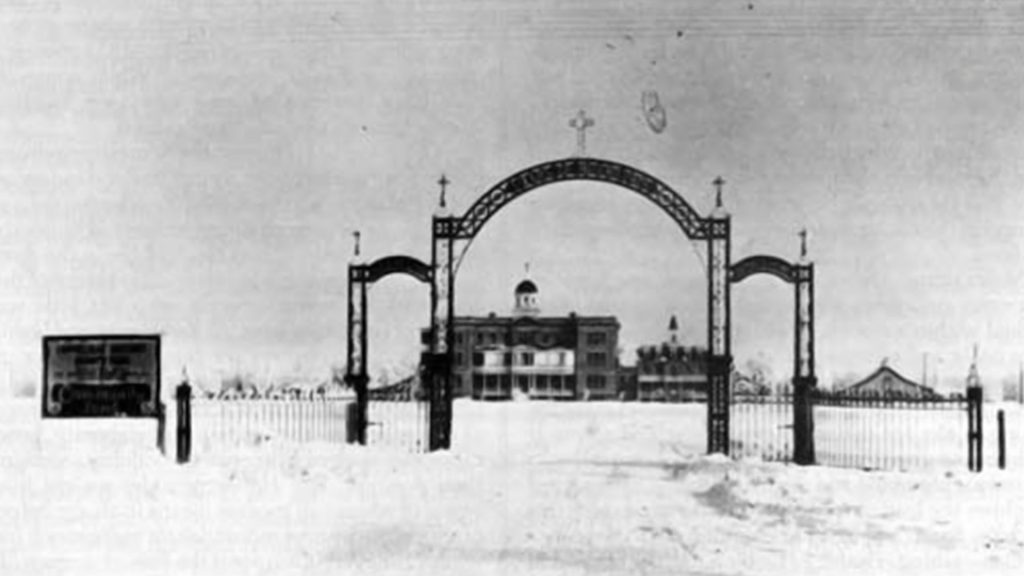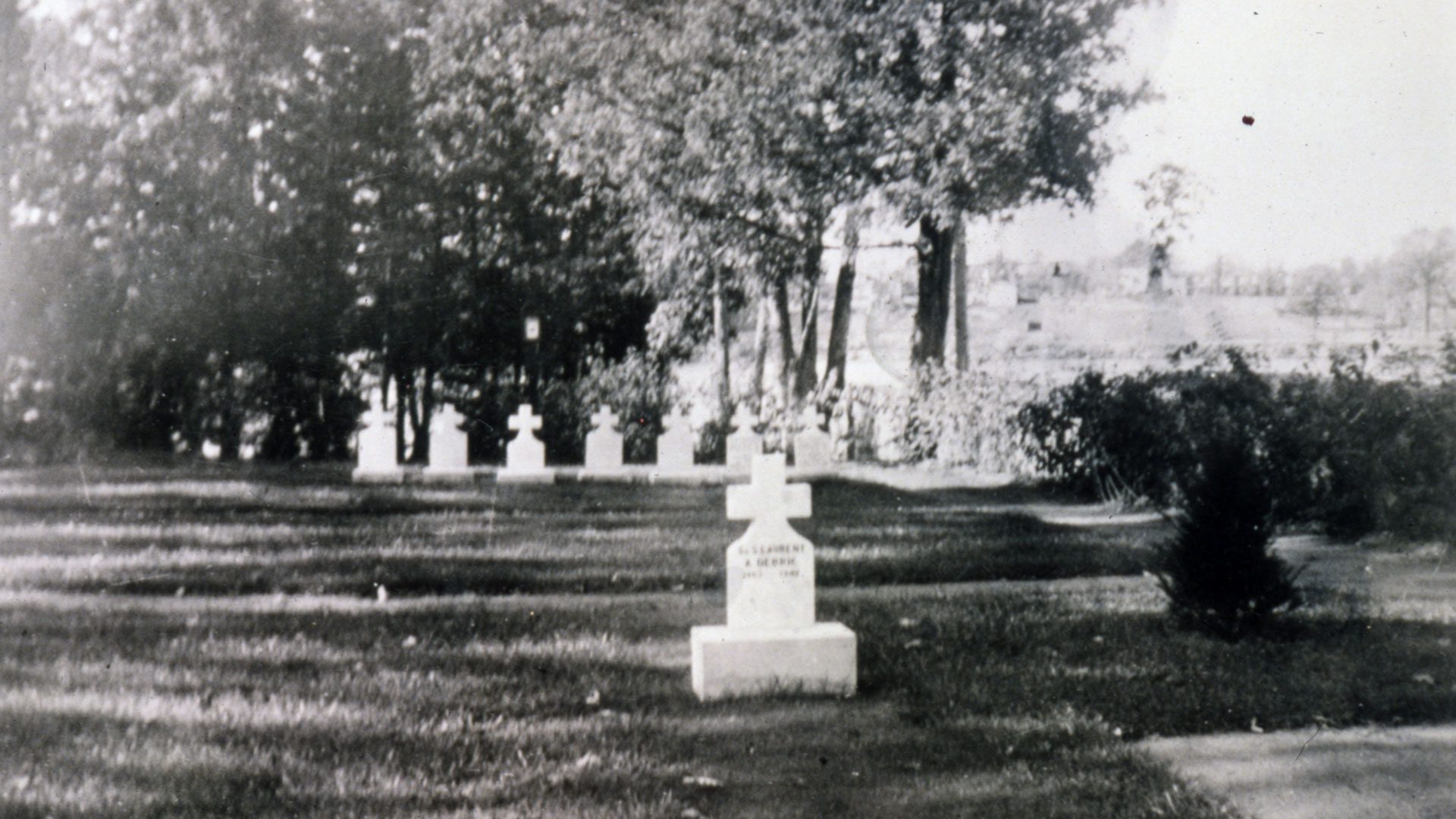
The front gate of l'Asile Ritchot in the 1930s. Photo courtesy: Société historique de St-Boniface (SHSB) Tellier fonds.
Warning: This story contains distressing subject matter
The Assembly of Manitoba Chiefs (AMC) is calling for a halt on the potential development of a possible “mass grave” site in south Winnipeg.
“We take this news very seriously and our hearts go out to the family and Nations of these little ones who were not given the opportunity to return home, even after they died,” said Grand Chief Cathy Merrick in a letter to Winnipeg Mayor Scott Gillingham.
“It is with heavy hearts, but solid determination, we will seek to repatriate these little ones so they can be laid to rest in the care of their loved ones.”
The letter, a copy of which was obtained by APTN News, asks for time to continue researching an unmarked cemetery near a former Catholic orphanage and home for unwed mothers in the suburb of St. Norbert.
“As such, the AMC is asking the City of Winnipeg to hold off on any development in this area in order to investigate the presence of unmarked mass graves.”
APTN has contacted Gillingham for a response.
Merrick said information provided by a greenspace advocacy group and the owner of the nine-hectare property show The Sisters of Misericorde (les Seours de Misericorde) operated l’Asile Ritchot between 1904 and 1948 on the south bank of the Red River.
Further research commissioned by AMC confirmed the cemetery contained both individual and mass graves dating from 1907 to 1918, she said in the letter.
“Approximately 1,500 burials, mostly in mass graves, include infants without parents or families without means for individual graves. Records also indicate hundreds of deaths are likely linked to the Sisters of Misericorde hospital.”
However, the exact location of the cemetery in what is now known as the Lemay Forest remains unknown.
Merrick said “non-invasive testing in both the development boundaries and the cleared area west of them” is needed.
‘Historical tragedy’
She thanked Tochal, the property owner that wants to develop the nine hectare [22-acre] parcel, for alerting AMC to this “historical tragedy.”
John Wintrup, a professional planner for Tochal in Winnipeg, said he contacted a number of Indigenous groups.
“We’ve done above and beyond consultation,” he said, noting he has also met with St. Norbert residents.
He told APTN that Tochal will not develop the area [less than a hectare or two acres] where the cemetery is believed to be located.
But OURS-Winnipeg, a greenspace advocacy group whose initials stand for Outdoor Urban Recreational Spaces, doesn’t want any development there.
“We’re a greenspace organization so that’s our primary interest in the property,” said Shelley Sweeney. “But having stumbled across this issue with the graves, I’m certainly going to bring it up as something the city certainly needs to come to grips with.”
Sweeney, an archivist emeritus with the University of Manitoba, says the property in question is located at the junction of the LaSalle and Red Rivers.
“Fr. Ritchot, who was the local parish priest, gave [river lot 85] to the Sisters of Misericordia … who were running a maternity hospital in the Misericordia Hospital in Winnipeg,” she said in an interview. “He gave the property for an orphanage and home for unwed mothers.
“As soon as I heard that there was an orphanage there I said, ‘Oh, there must have been a cemetery somewhere around here.’”
Sweeney said the original lot was 32 hectares [80 acres] and has been subdivided for different developments. She said her group wants to save the forest that’s still undeveloped.
City committee
The matter is scheduled to be heard by a city committee on Thursday. A spokesperson for the City of Winnipeg said Tochal has not submitted a development application.
David Chartrand, president of the Manitoba Métis Federation, said he would be meeting with the mayor to provide his opinion on the development.
“Some want it for leisure, some want it for development, some want it for cultural purposes, some want it for historical purposes,” he said in a telephone interview. “So there are a variety of different concepts to it. And, of course, one wants it for business.”
The building that housed the orphanage and mother’s home is still standing and home to the Behavioural Health Foundation, a residential addiction treatment facility.
But Foundation executive director Marla Somersall said her organization is not involved with the development.
“I can confirm the Behavioural Health Foundation did not sell the land to the developer,” she told APTN.
Sweeney said her research shows the land was owned by two Winnipeg businessmen, who sold it to a foundation, who sold it to Tochal.
Philippe Mailhot, a historian and former resident of St. Norbert, said he is unaware of any gravesites in the area behind what used to be l’Asile Ritchot.
“What I do know was it was operated as an orphanage and later as a seminary/residence for Oblate seminarians,” he said in an email to APTN. “There may have been a cemetery back there and if there was I am sure it would have been considered consecrated grounds.”
Ken Thorson, a spokesperson for the Missionary Oblates of Mary Immaculate (OMI) in Canada, confirmed OMI purchased the property from the Sisters of Mercy in 1948.
Sold the land
“In 1950, an Oblate novitiate (seminary) was established on the property,” he said in an email. “In the early 2000s … the Oblates sold the land. While there was developer interest, the Oblates sold the property to Laureate Academy.”
Sweeney said records show the death rate at l’Asile was high, especially in the early years.
Records suggest “anywhere between 1,288 to over 2,000 children died there. In 1909 for example, 188, or nearly 60 per cent of the 314 children who had been admitted, died.
“The ethnicity of the children was only reported for a subset of the population,” she added. “This indicates that there were Métis and a small number of First Nations and Inuit children who died at the Asile.”
APTN was unable to independently verify Sweeney’s findings Wednesday.
Calls and emails to the Catholic Diocese of St. Boniface and St. Boniface Historical Society were not returned, while a spokesperson for the National Centre for Truth and Reconciliation, which traces gravesites related to residential schools. was not available for comment.
Dana Derksen, president of the board of directors of the St. Norbert Community Club, said talk of developing Lemay Forest has been going on for three decades.
“That was an orphanage,” she said Wednesday. “We’ve known for years there are graves back there.”
Despite some reports that the cemetery may have been relocated, Derksen said she’s “inclined not to believe that … I’ve lived here for 50 years. That land has never been excavated. I don’t think that those graves were removed.”
Trace loved ones
Meanwhile, these types of gravesites are the responsibility of Kimberly Murray, Canada’s Independent Special Interlocutor for Missing Children and Unmarked Graves and Burial Sites associated with Indian Residential Schools.
“Indigenous children were taken either directly or to many other institutions by being transferred from the residential schools,” Murray said she has learned from families trying to trace their loved ones.
“So,secial mental health institutions, Indian hospitals, homes for disabled children – there’s like a whole bunch of more locations that I believe that there are burials.”
Her interim report from June 2023 also identified orphanages, she said.
“It’s from talking to survivors and families and communities that we know Indigenous children were taken to all these different types of institutions and buried on the same grounds,” she said in an interview Wednesday.
“We know that was the policy of Canada. The policy to not return children home when they died applied to all institutions – not just Indian residential schools. And Canada – its Indian agents – approved this.”
Murray noted she has sent letters to politicians seeking to stop property development in the past. She also said provincial governments have regulations around building on former cemetery sites.
The Indian Residential Schools Help Line 1-866-925-4419 is available 24 hours a day for anyone experiencing pain or distress as a result of their residential school experience.













